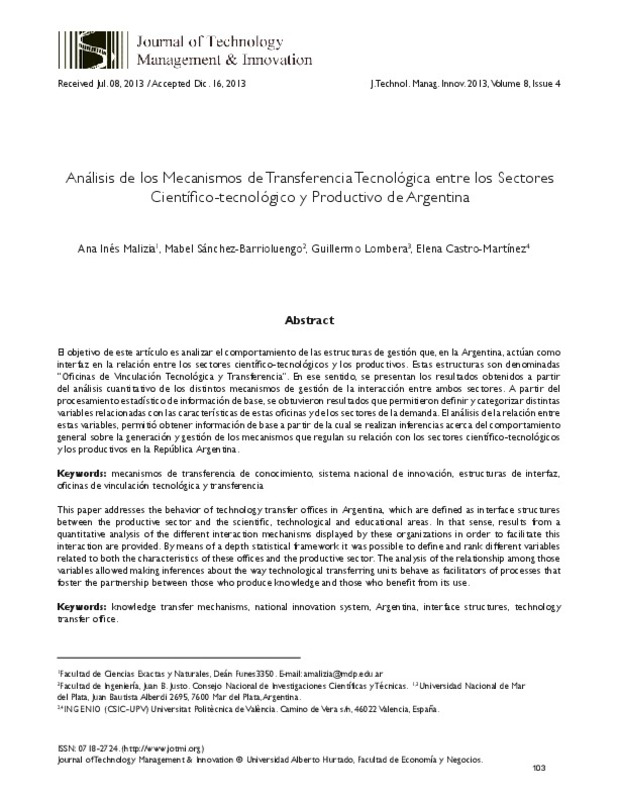JavaScript is disabled for your browser. Some features of this site may not work without it.
Buscar en RiuNet
Listar
Mi cuenta
Estadísticas
Ayuda RiuNet
Admin. UPV
Análisis de los Mecanismos de Transferencia Tecnológica entre los Sectores Científico-tecnológico y Productivo de Argentina
Mostrar el registro sencillo del ítem
Ficheros en el ítem
| dc.contributor.author | Malizia, A.I.
|
es_ES |
| dc.contributor.author | Sánchez-Barrioluengo, M
|
es_ES |
| dc.contributor.author | Lombera, G.
|
es_ES |
| dc.contributor.author | CASTRO-MARTINEZ, ELENA
|
es_ES |
| dc.date.accessioned | 2015-02-04T08:25:46Z | |
| dc.date.available | 2015-02-04T08:25:46Z | |
| dc.date.issued | 2013-12 | |
| dc.identifier.issn | 0718-2724 | |
| dc.identifier.uri | http://hdl.handle.net/10251/46703 | |
| dc.description.abstract | [EN] This paper addresses the behavior of technology transfer offices in Argentina, which are defined as interface structures between the productive sector and the scientific, technological and educational areas. In that sense, results from a quantitative analysis of the different interaction mechanisms displayed by these organizations in order to facilitate this interaction are provided. By means of a depth statistical framework it was possible to define and rank different variables related to both the characteristics of these offices and the productive sector. The analysis of the relationship among those variables allowed making inferences about the way technological transferring units behave as facilitators of processes that foster the partnership between those who produce knowledge and those who benefit from its use. | es_ES |
| dc.description.abstract | [ES] El objetivo de este artículo es analizar el comportamiento de las estructuras de gestión que, en la Argentina, actúan como interfaz en la relación entre los sectores científico-tecnológicos y los productivos. Estas estructuras son denominadas “Oficinas de Vinculación Tecnológica y Transferencia”. En ese sentido, se presentan los resultados obtenidos a partir del análisis cuantitativo de los distintos mecanismos de gestión de la interacción entre ambos sectores. A partir del procesamiento estadístico de información de base, se obtuvieron resultados que permitieron definir y categorizar distintas variables relacionadas con las características de estas oficinas y de los sectores de la demanda. El análisis de la relación entre estas variables, permitió obtener información de base a partir de la cual se realizan inferencias acerca del comportamiento general sobre la generación y gestión de los mecanismos que regulan su relación con los sectores científico-tecnológicos y los productivos en la República Argentina. | es_ES |
| dc.language | Español | es_ES |
| dc.publisher | Universidad Alberto Hurtado | es_ES |
| dc.relation.ispartof | Journal of Technology Management and Innovation | es_ES |
| dc.rights | Reconocimiento (by) | es_ES |
| dc.subject | Mecanismos de transferencia de conocimiento | es_ES |
| dc.subject | Sistema nacional de innovación | es_ES |
| dc.subject | Estructuras de interfaz | es_ES |
| dc.subject | Oficinas de vinculación tecnológica y transferencia | es_ES |
| dc.subject | Knowledge transfer mechanisms | es_ES |
| dc.subject | National innovation system | es_ES |
| dc.subject | Argentina | es_ES |
| dc.subject | Interface structures | es_ES |
| dc.subject | Technology transfer office | es_ES |
| dc.subject.classification | ESTADISTICA E INVESTIGACION OPERATIVA | es_ES |
| dc.title | Análisis de los Mecanismos de Transferencia Tecnológica entre los Sectores Científico-tecnológico y Productivo de Argentina | es_ES |
| dc.type | Artículo | es_ES |
| dc.identifier.doi | 10.4067/S0718-27242013000500010 | |
| dc.rights.accessRights | Abierto | es_ES |
| dc.contributor.affiliation | Universitat Politècnica de València. Departamento de Estadística e Investigación Operativa Aplicadas y Calidad - Departament d'Estadística i Investigació Operativa Aplicades i Qualitat | es_ES |
| dc.contributor.affiliation | Universitat Politècnica de València. Instituto de Gestión de la Innovación y del Conocimiento - Institut de Gestió de la Innovació i del Coneixement | es_ES |
| dc.description.bibliographicCitation | Malizia, A.; Sánchez-Barrioluengo, M.; Lombera, G.; Castro-Martinez, E. (2013). Análisis de los Mecanismos de Transferencia Tecnológica entre los Sectores Científico-tecnológico y Productivo de Argentina. Journal of Technology Management and Innovation. 8(4):103-115. doi:10.4067/S0718-27242013000500010 | es_ES |
| dc.description.accrualMethod | S | es_ES |
| dc.relation.publisherversion | http://dx.doi.org/10.4067/S0718-27242013000500010 | es_ES |
| dc.description.upvformatpinicio | 103 | es_ES |
| dc.description.upvformatpfin | 115 | es_ES |
| dc.type.version | info:eu-repo/semantics/publishedVersion | es_ES |
| dc.description.volume | 8 | es_ES |
| dc.description.issue | 4 | es_ES |
| dc.relation.senia | 253843 |








